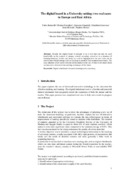| dc.contributor.author | Bertarelli, Fabio | |
| dc.contributor.author | Corradini, Matteo | |
| dc.contributor.author | Guaraldi, Giacomo | |
| dc.contributor.author | Genovese, Elisabetta | |
| dc.contributor.author | Kilwake, Juma | |
| dc.contributor.author | Mutua, Stephen | |
| dc.date.accessioned | 2019-05-22T10:37:32Z | |
| dc.date.available | 2019-05-22T10:37:32Z | |
| dc.date.issued | 2010-05-19 | |
| dc.identifier.uri | http://erepository.kibu.ac.ke/handle/123456789/1088 | |
| dc.description.abstract | Usually the digital board is thought of as a tool that can only be used
beneficially in the context of primary school, secondary school or in a situation of
learning handicap. In this case study we want to highlight how the new tools can be
used in more broad settings such as teaching in scientific and technical universities. The
easy adoption of all useful software on the market to the use of these tools makes them
an innovative element in the teaching techniques of the future | en_US |
| dc.language.iso | en | en_US |
| dc.publisher | Springer, Berlin, Heidelberg | en_US |
| dc.rights | Attribution-NonCommercial-ShareAlike 3.0 United States | * |
| dc.rights.uri | http://creativecommons.org/licenses/by-nc-sa/3.0/us/ | * |
| dc.subject | Digital whiteboard advanced teaching tools | en_US |
| dc.subject | Repository | en_US |
| dc.title | The digital board in a university setting: two real cases in Europe and East Africa | en_US |
| dc.type | Article | en_US |

